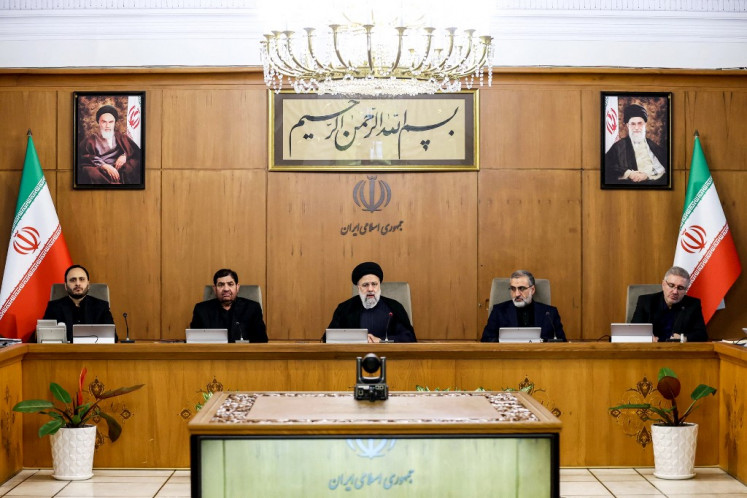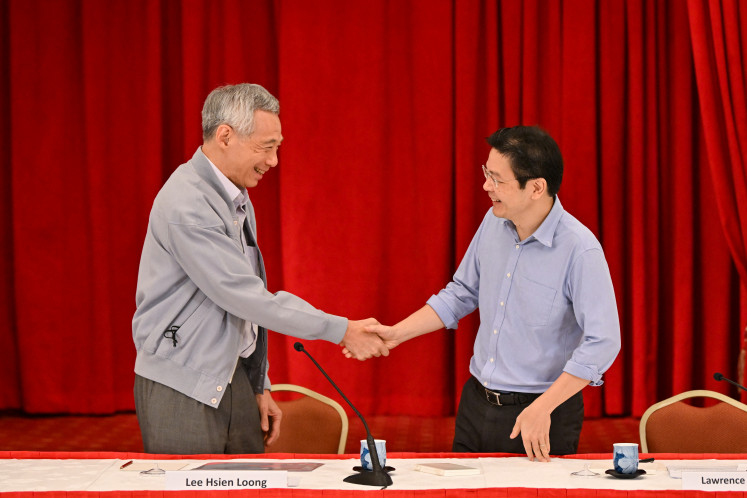The guardian of tradition
The founder of Neka Art Museum (NAM), Pande Wayan Suteja Neka, once said that he wanted the museum to be more than just a magnificent repository of treasured heritage
Change Size

The founder of Neka Art Museum (NAM), Pande Wayan Suteja Neka, once said that he wanted the museum to be more than just a magnificent repository of treasured heritage. He wanted the museum to be a temple.
Little did he know that his vision would one day be realized.
On the morning of Oct. 9, a group of Balinese people arrived at the museum. They were all dressed traditionally. The women carried offerings and fragrant incense. They didn’t come to take in the rich
collection of Balinese traditional paintings, nor the beauty of the museum garden.
“We are the descendants of Mpu Rudaya and we are here to present offerings to the krises created by our ancestor,” the group’s leader said.
Upon hearing his words the museum staff recognized that they had come to celebrate Tumpek Landep, a special day for Balinese Hindus, when offerings are presented to metal tools and iron objects, particularly to sharp weapons.
On this day, Balinese Hindus remove their family krises (heirloom knives) from their shrines and wash them with a mixture of holy water and fragrant perfume before adorning them with fresh coconut leaves and flowers. The family then presents offerings in front of the heirloom before partaking in a joint prayer. The ceremony usually takes place at the family shrine.
The descendants of Mpu Rudaya, however, had strong reasons to hold the ceremony at the museum instead of at their family temple in Jasi, Karangasem. They had learned that two of Rudaya’s most powerful krises were on display at the museum, and they believed that the water used in cleansing the krises would have the supernatural properties they desperately needed to counteract a series of unfortunate accidents which had befallen the family.
The group was escorted into the kris pavilion, a special wing opened in 2007 to house its kris collection.
The pavilion now boasts more than 200 krises of tangguh sepuh, fabricated before Indonesia’s independence in 1945, and tangguh kamardikan, fabricated after 1945. Included in the prized collection are 27 historical kris heirlooms of royal families from Bali and Lombok.
On a wooden desk in the center of the pavilion, three krises attributed to Mpu Rudaya rested inside their glass casings. They were Ki Baju Rante, Ki Baru Upas and Ki Baru Bengel.
Ki Baju Rante is a straight-edged kris with a simple form, free of intricate motifs and decorations.
However looks can deceive, because this kris was one of the most potent weapons in the arsenal of the Karangasem royal family.
During their glory days in the 18th century, the family expanded their influence into the neighboring island of Lombok. It is said that the King of Karangasem, Ida Angloerah Made Karangasem, wielded Ki Baju Rante during battles against the native Sasak warriors of Lombok.
“The form, shape and weight of this kris clearly indicate that it was designed to be a battlefield weapon, not a ceremonial one. It was also said that the Karangasem court blacksmith at that time, Mpu Rudaya, used a special type of steel to forge this kris, which enabled it to pierce through light armor,” Neka said.
Today, the descendants of Mpu Rudaya sit before the three krises. Neka and the museum staff retreat to another room, granting the family more privacy.
Upon the completion of the brief ceremony, the family approached Neka to convey gratitude for the museum’s preservation and care for the works of their esteemed ancestor. They departed, carrying a vessel filled with the holy water of the krises, a blessing from the past to solve the problems of the present. They promised to return for the next Tumpek Landep.
“I didn’t realize that the museum would actually become a temple where people come to pray and
ask for blessings from the divine,” Neka said.
The episode with Mpu Rudaya’s descendants and similar episodes with the other families in Bali enlightened Neka to the multiple roles and influences krises still wield over the Balinese daily life.
As a collector, Neka spent many years spending money to find the most aesthetically pleasing krises to ensure that the public could appreciate these unique pieces. He was perfectly aware of the other dimensions of the kris — the historical, the magical and the sociological, to name a few — but he purposefully and steadfastly focused on the aesthetical dimension.

“I am an old man now, and life has been very, very kind to me. In Bali, when a man reaches my age he
is reminded to shed his worldly ambitions and to assume the sacred duty of his family and clan. Well, I am of the Pande [blacksmith] clan, and it is our duty to protect, preserve and create the kris for our warriors,” he said.
Keris Bali Bersejarah, at 321 pages, is a visual tour de force and revealing narrative on every conceivable aspect of Balinese krises. The book is the clearest symbol of Neka’s acceptance of his new role as guardian of a sacred tradition. It took Neka and another kris aficionado, Basuki Teguh Yuwono, almost three years to write the book.
“Since 1945, only four books on krises have been published, including this one, while books on trivial things are published by the thousands,” the painter Hardi said about the book.
During the book’s launching on Dec. 12, Neka, sitting among his friends, smiled confidently. His hand caressed the golden handle of a tiny kris on his waist. He was ready for his new role.
— Photos Courtesy of Neka Art Museum









